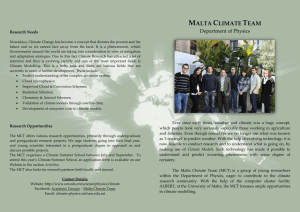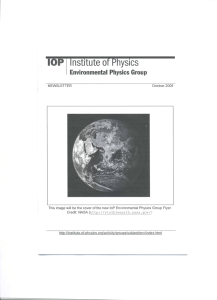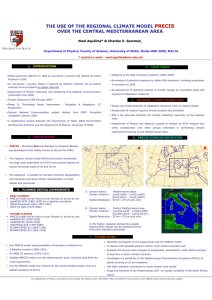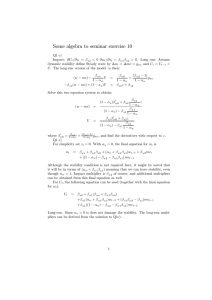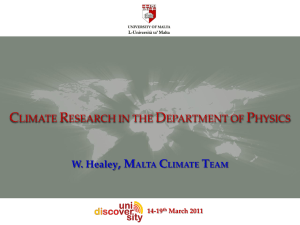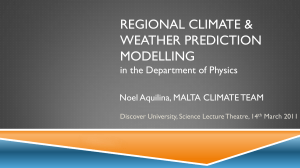Malta Climate Team
advertisement
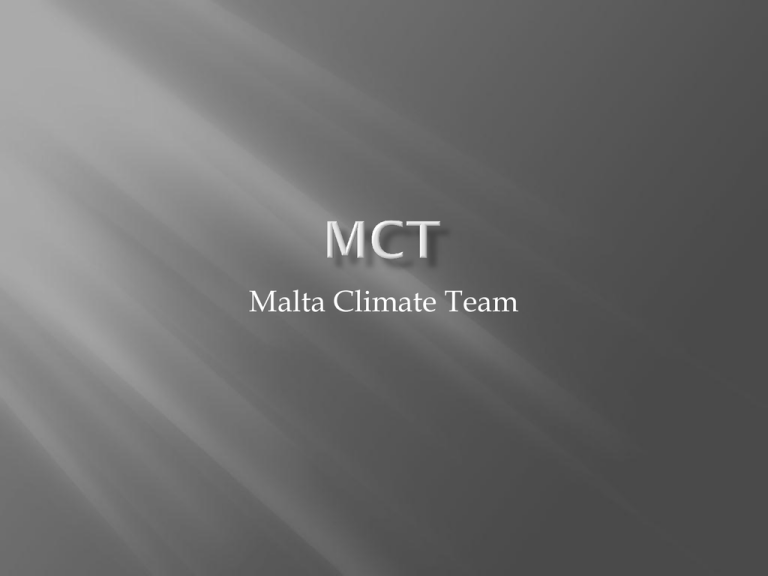
Malta Climate Team Change in weather patterns over a certain period of time Rainfall patterns Temperature Climate Change is defined by the IPCC as the change in the state of the climate that can be identified using statistical tests by changes in the mean, and or the variability of its properties, and that persists for an extended period, typically decades or longer. It refers to any change in climate over time, whether due to natural variability or as a result of human activity. Temperature change: 0.10 - 0.16 °C every decade from 1956 – 2005 Global Warming is tangible way to see Climate Change It means a rise in average temperature observed over a long period of time. We do not inherit the Earth from our ancestors but we borrow it from our children -Chief Seattle Consequences: • Change in frequency of Extreme events: • Decrease in cold days & cold nights. • Increase in hot days & hot nights including Heat Wave occurrence. • Increase of heavy precipitation events. • Precipitation change: • Increased in Eastern N/S America, N Europe & most of Asia. • Decrease in the Sahel, Mediterranean, S Africa & S Asia. • Increase in Global drought affected areas since the 1970s. • Sea level rise: • 1.3 - 2.3 mm per year (1961 - 2003) • 2.4 - 3.8 mm per year (1993 - 2003) • 57% due to thermal expansion The representation of the complex Earth system interactions through mathematical computer models. Computer models are used for weather prediction and long-term climate simulations. Climate Research is the use of Climate Models in order to simulate past, present and future events in an attempt to predict changes in climate. We need to assume different scenarios of how the world may change using the Intergovernmental Panel for Climate Change (IPCC) Special Report Emission Scenarios (SRES). These scenarios effect climatological parameters differently and are implemented within the Climate Models. A1 A1FI A2 B1 Focus on non-fossil Technologies. A1B Focus on Fossil-Intensive technologies. A1T Rapid economic growth. Population peak in mid century. Rapid introduction of new & more efficient technologies. B2 Balance between A1FI and A1T. Heterogeneous world. High population growth. Slow economic development. Slow technological change. Same global population as A1. Rapid changes in economic structures. Intermediate population growth. Intermediate economic growth. (L to R) Noel Aquilina, William Healey, Jason Padovani Ginies, Norbert Bonnici, James Ciarlo`, Candy Spiteri, Deandra Cutajar, Jessica Falzon The Department of Physics has been active on Climate issues since 2001. National Communications MEPA on behalf of the Government of Malta entrusted the Department of Physics with the coordination and preparation of the First (20012004) and Second National Communications (2004-2010) to the UNFCCC. Professor C.V. Sammut was the Project Manager and Professor A. Micallef was the National Expert. The setting up of the MCT Following the FNC, the license to operate the first regional climate model, PRECIS was acquired. Since then Dr N. Aquilina led the climate research and formed the MCT. Regional Climate Models PRECIS Providing REgional Climates for Impact Studies by the Hadley Centre, UK Met Office RegCM4.0 Regional Climate Model version 4.0 Developed by NCAR; maintained by the ICTP Numerical Weather Prediction Model WRF Weather Research and Forecasting Developed by NCAR, NCEP, FSL, AFWA, University of Oklahoma, and FAA. Undergraduate Projects 2009-2010 Subject: Validation of the RCM PRECIS in the Mediterranean Region: across Vertical Levels – Nadine Napoli in different Climate Zones – Denise M. Cilia the impacts of Sulfate Aerosols – James Ciarlo` Recent Publications Aquilina N. J., Ciarlo` J. M. (2011). “Evaluation of the effect of sulfate aerosols using the Regional Climate Model PRECIS”. Submitted in Climatic Change. Undergraduate Projects 2010-2011 Study of the El-Niño Southern Oscillation in the Australian region using PRECIS. Comparative Study of the Land Surface Models of PRECIS Candy Spiteri William Healey Postgraduate Projects Study of Oscillation Patterns around the Mediterranean Region and their influence on Aerosol transport using RegCM4. James Ciarlo` Other Projects Study of how increased aerosol activity influences humidity. Jason Padovani Ginies & James Ciarlo` Reproducing Tropical Cyclone Yasi using WRF. Norbert Bonnici & Jason Padovani Ginies The MCT runs its weather and climate models on the Computer Cluster Facility, ALBERT at the University of Malta. Undergraduate and Postgraduate Research Projects in Climate Science are offered by the MCT. The MCT organizes Summer Schools consisting of a series of lectures and workshops intended for students who want some experience into climate research. The MCT is highly interested in contributing to model development within the international scientific community. For this purpose physicists, chemists, programmers, mathematicians, statisticians and biologists are encouraged to join the MCT. W: http://www.um.edu.mt/science/physics/climate FB: Academic Group - Malta Climate Team E: climate-physics.sci@um.edu.mt
